Getting To Know Plants
There is a large number of plants growing around us. These differ in shape, size, color, and height. Some plants are small, some are very big and some are just patches of green on the soil.
Some plants have green leaves, while B some have reddish ones. Similarly, some plants have huge red flowers, while, some have tiny blue ones.
Some unwanted plants grow in crop fields, lawns, or in pots. These are known as weeds, for example, bermuda grass. They all are living entities, but are different from animals. They grow on soil and remain fixed in one place.
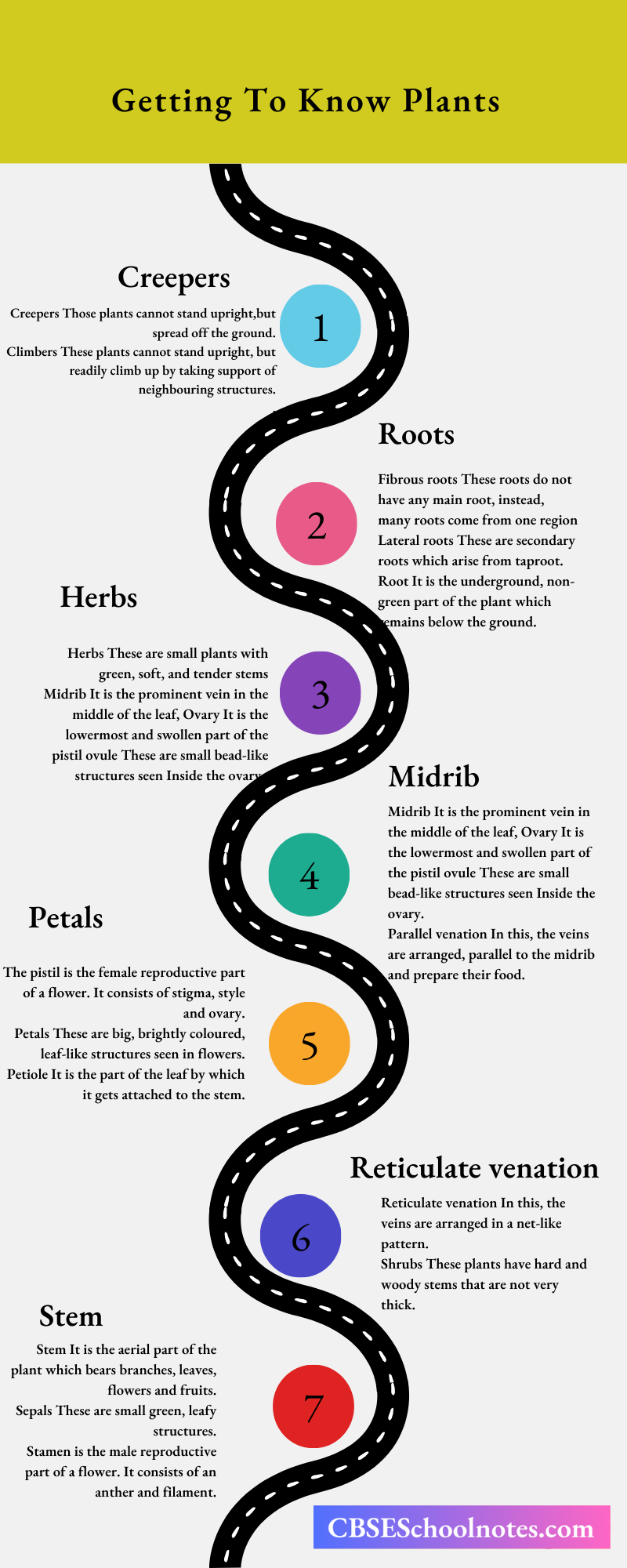
Types Of Plant
According to their size and nature of stem, plants are classified into the following three categories
- Herbs These are small plants with green, soft and tender stems. They do not have many branches, for example, bathua, tomato, paddy, grass, mint, etc.
- Shrubs These are bigger than herbs. Their stem is hard, but not very thick and has branches at the base of the stem, for example, jasmine, lemon, rose, tulsi, etc.
- Trees These are very tall and have hard and thick brown stems. The stems have branches on the upper part of the plants, for example, neem, mango, peepal, etc.
Read and Learn More Class 6 Science Notes
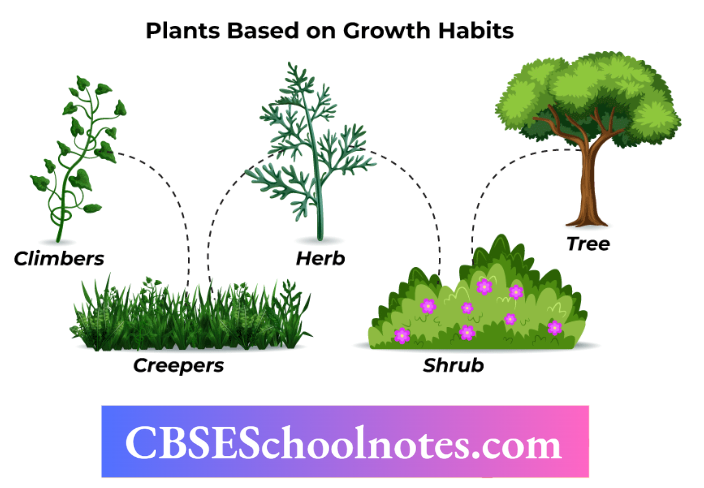
There are some plants which are different from herbs, shrubs and trees. These are called creepers and climbers.
Creepers are plants that have thin, long and weak stems which cannot stand upright but spread on the ground, for example, strawberries, pumpkins, watermelons, etc.
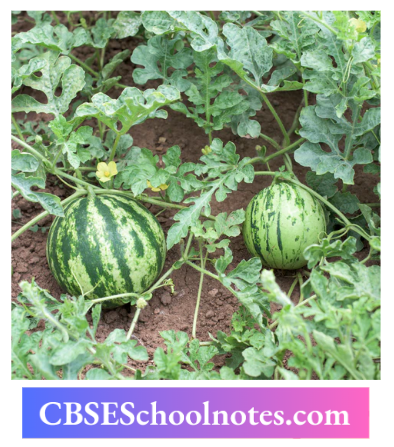
Climbers are plants having soft, green and weak stems which cannot stand upright just like the creepers, but readily climb up taking support from nearby objects or trees, for example, bitter gourd, grapevines, bean stalks, etc.
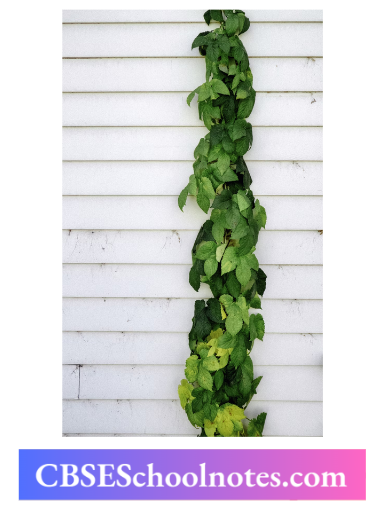
Science Insight A climber plan, has special organs called tendrils for climbing. Some of these have stem tendrils whereas others have leaf tendrils.
Parts Of A Plant
A plant is divided into different parts, i.e. stem, leaves, roots, etc. Each part performs a specific function.
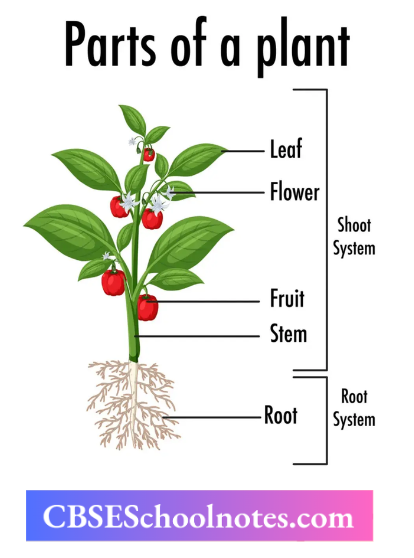
Stem
It is the aerial part of the plant which bears branches, flowers, buds, leaves and fruits. It may be green, hard or woody.
Functions Of Stem
It performs the following functions
- It helps in the upward movement of water and minerals from roots to different parts of the plants.
- The stem also conducts food from leaves to various plant parts through narrow tubes present inside it.
- Some stems get modified into various other forms in different plants to perform special functions, like in potato, onion and ginger, the stem is underground and modified to store food.
Leaf
It is a thin, flat and green part of the plant. Leaves of different plants have different shapes and sizes.
Parts of a Leaf
A leaf has the following parts
- Petiole (leafstalk) It is a thin stalk by which the leaf is attached to the stem.
- Lamina (leaf blade) It is the broad, green flattened part of a leaf. There are several small, thin lines running across the lamina called veins the central vein or the main vein of the leaf is called Madrid.
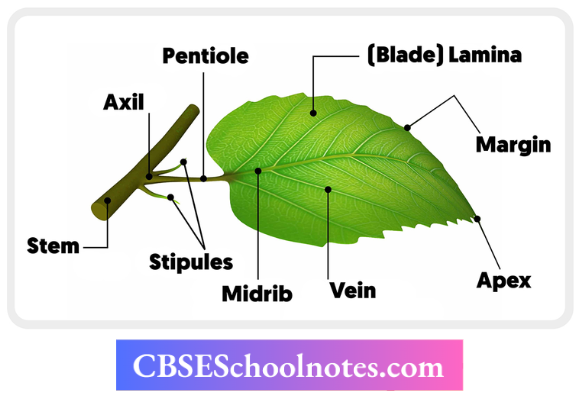
Science Insight A leaf without a petiole is called a sessile leaf. In such plants, the leaves are attached directly to the plant stem.
Leaf Venation
The arrangement of veins in the leaf lamina is called leaf venation. There are two types of venation seen in different plants.
- Reticulate Venation In this type of venation, veins are arranged in a net-like pattern on both sides of the midrib. This type of venation is found in peas, neem, peepal, tulsi, mustard, sunflower, orange, guava, rose etc.
- Parallel Venation In this type of venation, veins are arranged parallel to each other and also along the midrib. This type of venation is found in certain plants like wheat, maize, onion, garlic, lily grass, etc.
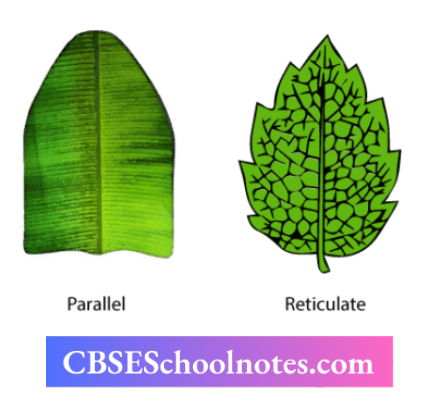
Functions of Leaves
They perform the following functions
- Leaves prepare their food in the presence of sunlight with the help of a green-coloured substance present in them. For this, they use water and carbon dioxide from the air. This process is called photosynthesis. Oxygen is given out in this process. The food prepared by leaves ultimately gets stored in different parts of the plant.
- They also help the plant to get rid of excess water by the process of transpiration.
Root
It is the underground, non-green part of the plant which remains below the ground, i.e. in soil.
Types of Root
There are mainly two types of roots
- Tap Root In some plants, there is one thick main root called tap root from which arises the smaller roots called lateral roots. Tap root grows vertically downwards into the soil and lateral roots spread in various directions. It is found in plants like peas, radishes, carrots, neem, mango, tulsi, marigolds, mustard and balsam.
- Fibrous RootIn some plants, there is no main root. All roots are similar and make a bushy appearance. This type of root is called fibrous root. It is found in plants like onion, lily, wheat, maize, grass and millet.

Functions Of Roots
They perform the following functions
- Roots anchor the plant to the soil. This prevents the plant from being pulled out easily or blown away by strong winds.
- They also absorb water and minerals from the soil. This helps in the manufacture of food by leaves.
- They hold the soil together. In this way, roots prevent the soil from being blown away by wind or washed away by water. This also helps in the conservation of soil.
- They help in the storage of food. Radish, carrot and turnip eaten by us are swollen tap roots. Similarly, Dahlia and sweet potatoes are fibrous roots which get modified to store food.
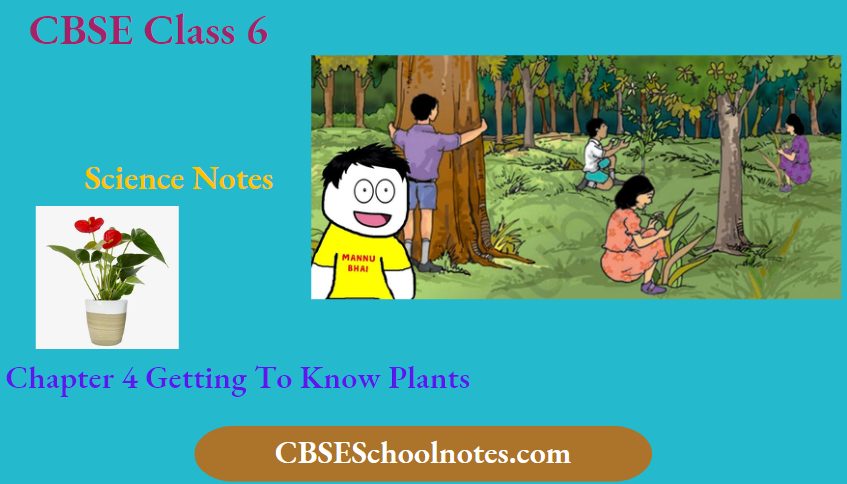
Flower
It is the reproductive structure of the plants. A flower has a stalk by which it is attached to the stem. Different types of plants bear different types of flowers, but the basic structure is almost the same in all plants (except a few).
Parts Of The Flower
A typical flower consists of four distinct parts or whorls, i.e. sepals, petals, stamens and pistils.
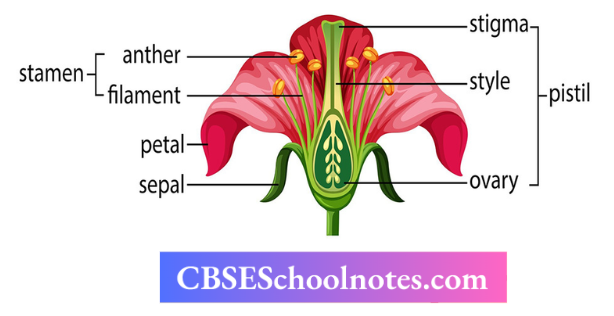
Sepals
The sepals form the outermost whorl of the flower. These are small, green leaf-like structures. They protect the flower in the bud stage.
Petals
They form the second whorl of flower lying inner to sepals. Petals are generally big and coloured structures. They vary in shape, size and structure in different plants. These are mostly bright in colour to attract insects, animals and even human beings.
Stamens
It is the third whorl of flower that lies inner to petals. Stamens are the male reproductive part of a flower and consist of two parts
Anther is the swollen long structure at the tip of each stamen. It contains a small powdery substance called pollen grains.
Filament is a long slender stalk-like structure which supports the anther.
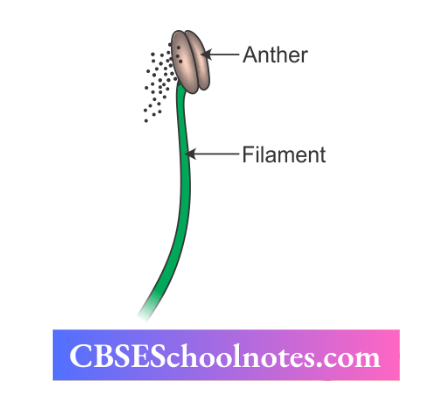
Pistil
- The innermost part of a flower is called a pistil. This is the female reproductive part of a flower.
- It consists of the following three parts
- Stigma is a slightly swollen part at the top of the style. It is a small, round and sticky part that traps the pollen grains.
- Style is a long, thin and slender stalk in the middle that is attached to the stigma.
- The ovary is the swollen part present at the lowermost portion. It contains many ovules (egg-like structures).

Science Insight The fruits and seeds are formed from flowers by the process of pollination and fertilization.
Activity 1
Aim: To show that water moves up through the stem of a plant.
Materials Required: A glass filled with water, red ink, stem of balsam plant, sharp object/knife, dropper.
Procedure:
- Take a glass filled with one-third of water and add some drops of red to it using a dropper.
- Cut the base of the stem of the balsam plant (or any other herb) carefully using a knife and put it in the glass.
- Observe the plant the next day.
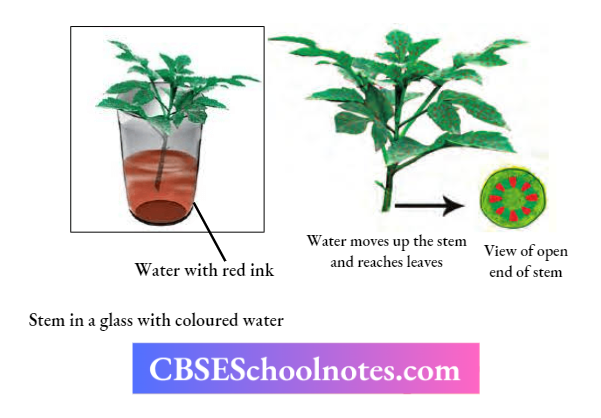
Observation We will observe that the colour rises in the stem, i.e. some parts of the stem become red. If this is kept for a longer period, the colour will appear in the veins of the leaves also.
Conclusion This activity shows that the stem helps in the upward movement of water and minerals to leaves and other parts attached to the stem.
Activity 2
Aim: To make the impression of the leaf on a white paper.
Materials Required: A white sheet of paper, a pencil, and a leaf of any plant.
Procedure:
- Put a leafunder a white sheet of paper.
- Hold it in place and start rubbing your pencil tip gently over the portion ofthe paper covering the leaf, keeping the pencil tip sideways.
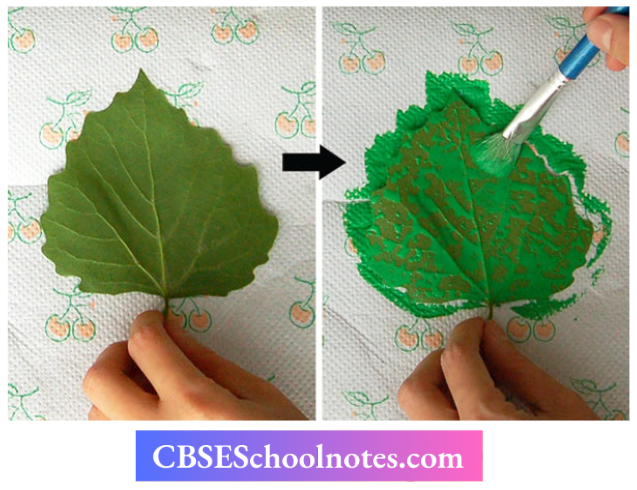
Observation: We will get the impression with some lines, i.e. leaf impressions are seen on the sheet defining its shape, size and venation.
Conclusion: This activity shows that the impression ofthe leaf is similar to that of the original leaf.
Activity 3
Aim: To show transpiration in plants.
Materials Required: A healthy plant, two transparent polythene bags and thread.
Procedure:
- Take a well-watered, healthy plant that has been growing in the Sun.
- Enclose a leafy branch of the plant with one of the polythene covers and tic up its mouth with thread.
- Take the other polythene bag and tie up its mouth with thread. Keep it in the Sun just like the previous one
- After a few hours observe the inner surface of the covers.
- Remove the polythene bag after the activity
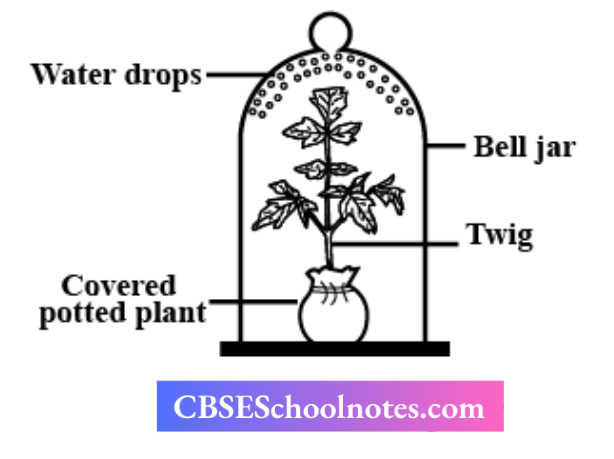
Observation: We observe that after some time small droplets of water appear inside the polythene bag covering the leafy branch of the plant.
This is due to the loss of water from the leaves which occurs by the process known as transpiration. Water droplets do not appear inside the empty polythene cover since the plant is absent.
Conclusion: This activity shows that transpiration is performed by the leaves.
Activity 4
Aim: To show that a leaf produces starch as a result of photosynthesis.
Materials Required: A leaf, spirit, a beaker, test tube, tripod stand, burner, water, iodine solution, dropper and watch glass.
Procedure:
- Take a test tube and put a leaf in it.
- Pour spirit into the test tube, so that the leaf gets completely immersed in it,
- Now, place this test tube in a beaker half-filled with water.
- Heat the beaker till all the green colour from the leaf comes out into the spirit in the test tube.
- Take out the leaf carefully and wash it with water.
- Place the leaf in a watch glass and pour iodine solution over it using a dropper.
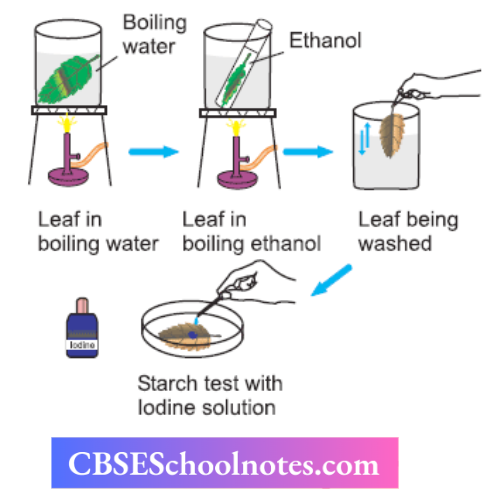
Observation: The leaf turns blue-black showing the presence of starch in it.
Conclusion: This activity shows that leaves contain starch which is the product of photosynthesis.
Activity 5
Aim: To test that roots are essential for the plant.
Materials Required: Two pots, some soil, a blade or a pair of scissors, khurpi (for digging) and water.
Procedure:
- Select two plants ofthe same kind from an open ground.
- Dig them out with roots, taking care that roots do not break.
- Place one ofthe plants in pot A.
- Cut off the roots from the other plant, and place this plant in pot B.
- Water them regularly
- Observe both plants after a week.
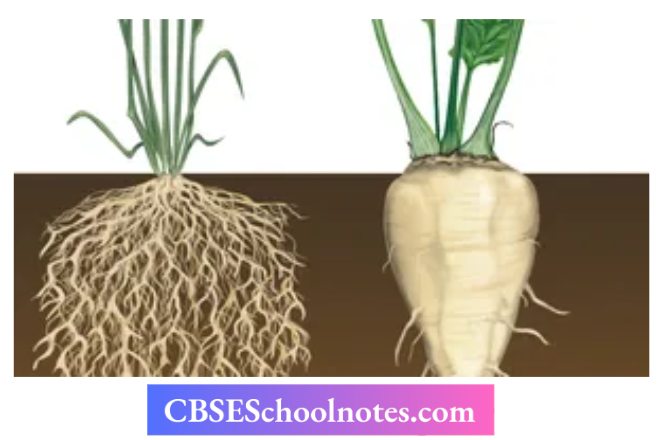
Observation: We will observe that the plant with roots planted in pot A is healthy and alive, while the plant without roots in pot B is wilted and gradually dies.
Conclusion: This activity shows that roots are necessary to keep the plant healthy and alive.
Activity 6
Aim: To see that plant roots hold/anchor the plant in the soil.
Materials Required: Seeds of gram and maize, bowls, cotton wool and water.
Procedure:
- Take two bowls and place some wet cotton in them.
- Put 3-4 seeds of gram in one bowl and maize in the other.
- Keep the cotton wet by sprinkling water every day, until the sprouts have grown into young plants.
- After a week, try to separate the young plants from the cotton.
Observation: We will find that it is difficult to pull the plant out as roots established anchor the plant firmly. Conclusion This activity shows that plant roots help in holding the plant firmly in the soil.
Activity 7
Aim: To observe the structure of an ovary in a flower.
Materials Required: Flowers of China rose, a blade, water, a magnifying glass, and a sheet of paper.
Procedure
- Take 2 flowers of China rose.
- Remove sepals and petals.
- With the help of a blade, carefully cut the ovary of one flower longitudinally and of another flower transversely.
- Put a drop of water on the cut pieces of ovary to Prevent drying
- Observe the structures with a magnifying glass
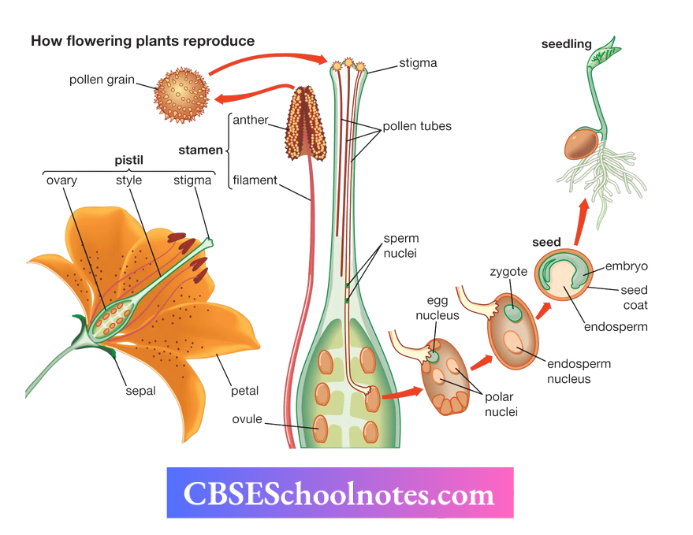
Observation: We will observe small bead-like structures inside the ovary.
Conclusion: Small bead-like structures inside the ovary are called ovules.
